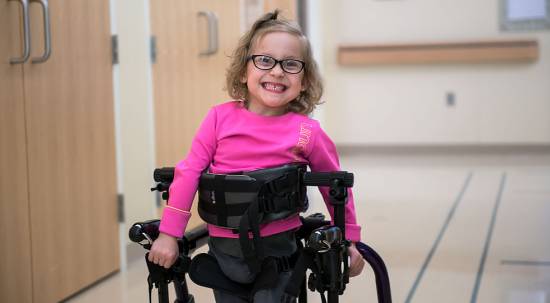Selective Dorsal Rhizotomy (SDR) Surgery

The Day of Surgery
Arrival
Our Perianesthesia staff greets you upon arrival. Your child is weighed and asked to change into a hospital gown. We also check temperature, pulse and blood pressure. A child life specialist uses toys, crafts or movies to help your child feel more at ease.
Surgery Preparation
Next, you and your child meet with the surgery team: the operating room nurse, neurosurgeon, nurse anesthetist and anesthesiologist. This is time for you to raise any questions or concerns—the anesthesiologist discusses how anesthesia and pain medication are used during surgery. You might talk about your child’s experiences with pain and request medication or other techniques to help decrease anxiety.
Surgery
Right before surgery, the surgeon marks the places on your child where incisions will be made. Your child inhales anesthesia through a mask or receives it through an IV tube. When your child is unconscious, we insert a breathing tube. If we haven’t placed an IV tube previously, we do it now. Your child receives anesthesia and fluids through the IV tube during and after surgery—our expert staff monitors breathing throughout the surgery.
The neurosurgeon makes an incision low in your child’s back and opens up the spinal canal. Through that space, the surgeon can access the sensory nerve roots that carry messages from the central nervous system to the muscles.
The neurosurgeon separates the roots into smaller rootlets and stimulates each rootlet with an electrical impulse. We then cut the rootlets that cause abnormal responses, leading to a permanent reduction in muscle spasticity.
The procedure usually lasts three to four hours, during which time we might test more than 100 rootlets. When SDR surgery is complete, the neurosurgeon closes the spinal canal and incision.
Coming Out of Surgery
Following the operation, your child starts out at the Postanesthesia Care Unit (PACU)—this is where they wake up and you join them. Shortly afterward, nurses ask your child about pain and provide medication for pain management and comfort if needed. The neurosurgeon meets you in the PACU to discuss the surgery and recovery process.
Shortly after surgery, you might notice temporary changes in your child’s appearance. For example, their face and hands might be puffy due to body position during surgery. There might also be redness around your child’s eyes and lips. That’s because we often place protective tape over the eyes and around the mouth to keep the breathing tube in place.
After Surgery
After the PACU, your child likely moves to the Rehabilitation Unit. During the first hours here, a nurse frequently checks blood pressure, pulse, temperature and breathing. We also check circulation in the arms and legs.
We give pain medicines and fluids through an IV tube. We also use a monitor to track vital signs. If at any time your child’s heart rate or breathing rate changes significantly, an alarm will sound.
First Three Days After Surgery
Most kids spend about three days in a hospital bed recovering from SDR surgery. Initially, pain medication and nourishment are administered through an IV. A catheter drains urine from the bladder. Nurses closely monitor patients to ensure safety and comfort. Later, nurses play an important role in helping patients practice what they learn during rehabilitation therapy.
One parent or adult caregiver can stay in a patient’s hospital room at night. You’re welcome to bring your child’s favorite foods to eat during the hospital stay.
Showers, laundry machines and a refrigerator are available for family members to use. You can access a variety of amenities—including the Ronald McDonald Family Room®— during your stay at Gillette.
Inpatient Rehabilitation After Surgery
Pediatric rehabilitation medicine physicians direct the rehabilitation plan, which begins about three days after surgery. The inpatient rehabilitation program usually lasts four to six weeks, but the length of time can vary depending on your child and family's circumstances. Shortly after surgery, your child's rehabilitation team can provide an estimate of how long the rehabilitation stay will last.
Physical therapists work with your child on basic skills, such as head and trunk control. Later skills include crawling, standing and walking. Slowly building on skills is vital. If your child performs advanced activities too soon, they risk reverting to the abnormal movement patterns they used before surgery.
Occupational therapy helps your child learn new techniques for getting dressed after SDR surgery. Patients also work on mobility and balance during occupational therapy to help them return to regular activities. Therapeutic recreation services help patients learn and practice skills using activities like sports or games.
In addition to undergoing comprehensive rehabilitation therapy during your child’s hospital stay, you’ll have access to a full range of child and family support services and to collaborative medical, surgical, rehabilitation and assistive technology specialists.
Your child might receive services from:
